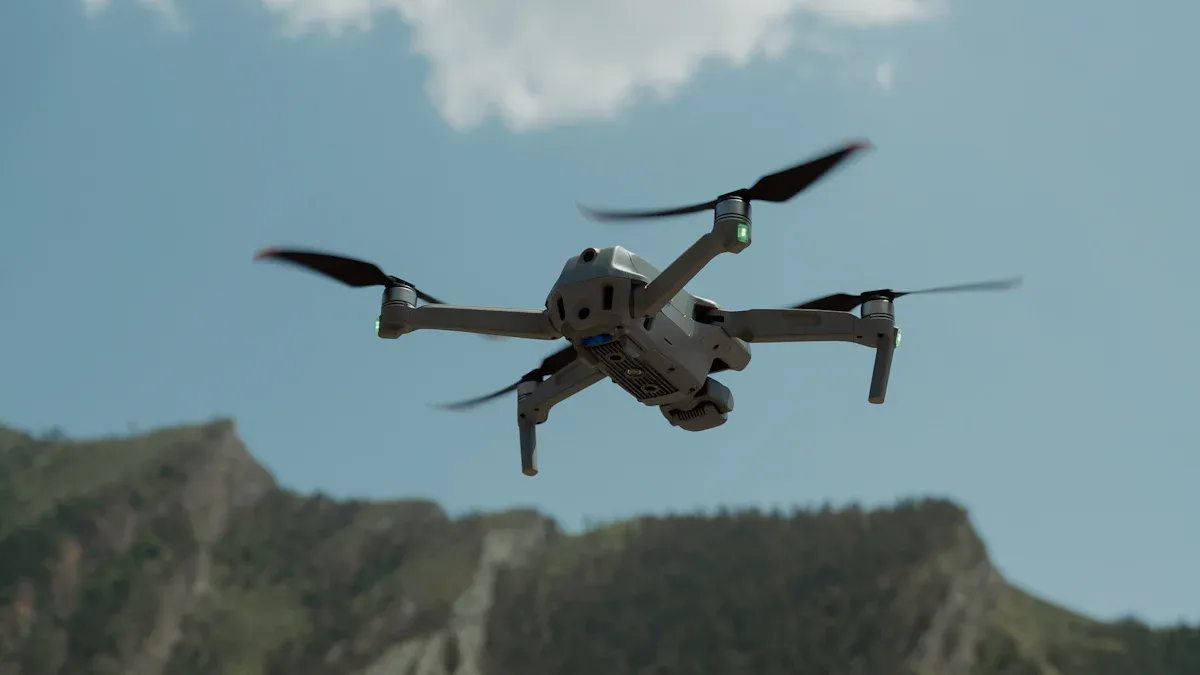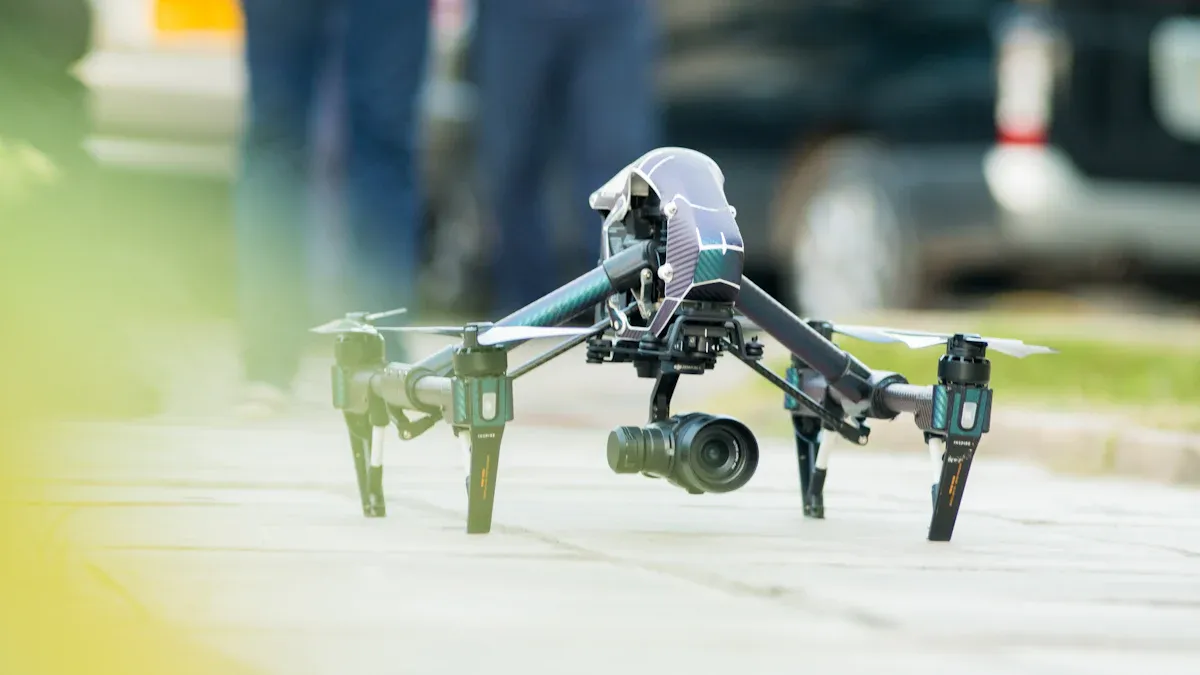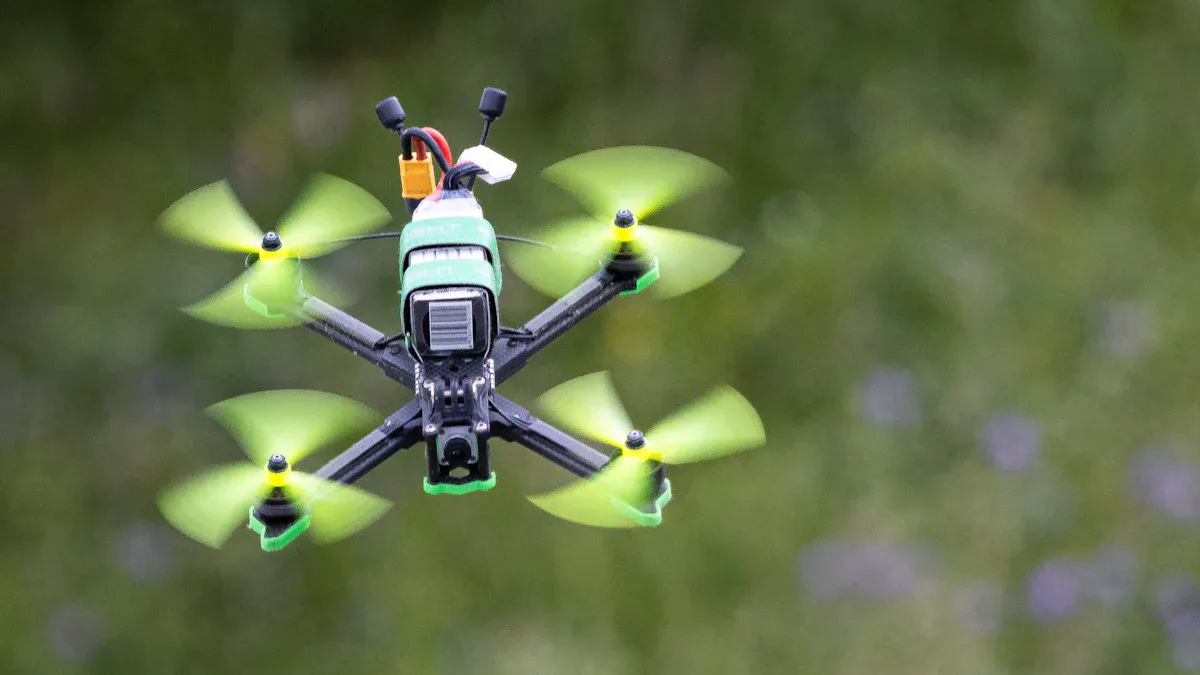How to Select the Right FPV Drone for Your Payload Needs

When you pick an FPV drone, understanding the fpv drone payload is crucial. The payload capacity indicates how much weight your drone can carry, which directly impacts its flight performance. For instance, a drone's maximum takeoff weight (MTOW) encompasses both the drone's weight and its fpv drone payload. Exceeding this limit can lead to a loss of stability and safety.
Additionally, increasing the weight affects battery life. A drone without any payload can typically fly for about 39.6 minutes, but this duration decreases as you add more weight. Therefore, consider your requirements and the gear you intend to carry when selecting your FPV drone.
Key Takeaways
Know how much weight your drone can carry. This helps you understand its limits.
Pick light gear to help your drone fly longer. Lighter items mean longer flight times.
Always follow the weight limits given. Keeping your load under 70% helps your drone stay stable.
Think about things like wind and heat. These can change how well your drone works.
Choose the right battery for weight and power. A good battery helps your drone fly better and longer.
Importance of Payload Capacity

Why Payload Matters
It is important to know about payload capacity when choosing an FPV drone. The payload capacity affects how long the drone can fly and how stable it is. A drone needs to carry the right equipment based on its payload capacity. For example, if a drone can weigh 10 kg and it weighs 4 kg, it can carry 6 kg. This shows why knowing your drone's payload limits is important.
When you add weight to a UAV, it needs more power to take off. While hovering, the power must match the drone's weight. Ideally, a drone should have at least double the power needed to hover. This helps keep it stable and flying smoothly.
Here are some things that affect payload capacity:
Structural Design: The frame's size and shape affect how much weight the drone can hold. Fixed-wing drones can carry heavier loads.
Motor Configuration: More motors help spread the weight better, allowing for heavier cargo.
Thrust: Bigger rotors and better designs give more power, increasing payload capacity.
Power System: Larger batteries help lift more weight and let the drone fly longer.
Center of Gravity: Where you place the weight can change the center of gravity, which affects stability and performance.
Common Payload Types
Different payloads are used for various tasks with FPV drones. Here are some common payload types you might think about:
Payload Type | Description and Applications |
|---|---|
Cameras | Used for taking photos, videos, watching over areas, and checking things. Types include: |
- Standard Cameras: For general photos and videos. | |
- High-Resolution Cameras: For clear images in professional work. | |
- 360-Degree Cameras: For wide views and immersive experiences. | |
Sensors | Thermal imaging, LiDAR, and multispectral sensors for checking the environment and farming. |
- Thermal Sensors: Measure heat for rescue, building checks, and wildlife watching. | |
- LiDAR: Makes 3D maps, used in surveys and studies. | |
- Multispectral Sensors: Help analyze crop health in farming. | |
Delivery Packages | Used for shipping and supply chain tasks. |
Scientific Instruments | For research, including studies of the atmosphere and earth. |
Sprayers | For farming tasks like spraying pesticides or fertilizers. |
Knowing these payload types helps you pick the right FPV drone for your needs.
Calculating Payload Capacity
Knowing your drone's details is key to figuring out its payload capacity. You must understand how much weight your drone can safely carry. This helps you choose the right gear for your needs.
Understanding Drone Specifications
Maximum Takeoff Weight
The maximum takeoff weight (MTOW) is the most weight your drone can fly with. This includes the drone's weight and any extra gear you want to carry. To find the MTOW, look at the manufacturer's details. If your drone weighs 2 kg and has an MTOW of 5 kg, you can carry up to 3 kg of payload. Always stay within this limit for safe flying.
Recommended Payload Guidelines
Most manufacturers give recommended payload guidelines. These guidelines show you the best weight for your drone. Carrying too much weight can cause problems. A good rule is to keep your payload under 70% of the maximum capacity. This helps with stability and flying better.
How to Measure Your Payload
Weighing Equipment
To measure your payload correctly, you need a good scale. Use a digital scale for accurate readings. Put your equipment on the scale and write down the weight. This step makes sure you know exactly how much weight you will add to your drone.
Estimating Drone Weight
Estimating your drone's weight is also important. If you can't find your drone's exact weight, use a similar model's weight as a guide. This helps you figure out the total weight when adding your drone payload. Always remember that accurate measurements lead to better flying.
Factors Affecting Flight Performance
Weight and Stability
Weight is very important for your FPV drone's stability. When you add more payload, the propellers need to work harder. This means they spin faster, using more battery power. Because of this, your battery life gets shorter, and you fly for less time. To keep your drone stable, make sure its weight is within safe limits. A balanced drone flies better and feels smoother.
Speed and Maneuverability
Speed and maneuverability are key for flying your drone well. Here are some performance factors that show how these things affect your FPV drone:
Impact on FPV Drone Operation | |
|---|---|
Battery Life | Shows how long your drone can stay in the air. |
Motor Efficiency | Affects how much power it uses. |
Aerodynamics | Influences how stable and fast the drone flies. |
Tells how much weight your drone can carry. | |
Propeller Design | Important for thrust and lift. |
When you improve these areas, your drone works better overall. For example, using good motors can help your drone go faster while saving battery.
Environmental Considerations
Outside conditions can greatly affect how your drone performs. Here are some environmental factors to think about:
Impact on Drone Performance | |
|---|---|
Air Temperature | Affects how long your drone can fly and how it moves. |
Wind Speed | Changes how well you can control the drone while flying. |
Precipitation | Can make it hard to see and affect how sensors work. |
Altitude Above Sea Level | Relates to how thick the air is, which affects lift and flying time. |
Electromagnetism | High levels can mess with the drone's sensors. |
Stability of Takeoff/Landing | Moving surfaces like boats or trucks can make flying safely harder. |
Knowing these environmental factors helps you get ready for different flying situations. By thinking about weight, speed, and outside conditions, you can choose the best FPV drone for your needs.
Battery Life and Payload Relationship

How Weight Affects Battery Drain
Adding weight to your FPV drone makes it need more thrust to take off. This means your drone has to work harder to stay in the air. Drones usually have a maximum thrust that is twice what is needed for hovering. When the payload weight goes up, the flight time goes down. Heavier loads mean shorter flights because the drone uses more battery power.
Tip: Always think about your equipment's weight when planning your flight. A lighter setup can help your drone fly longer.
Choosing the Right Battery for Your Payload
Picking the right battery for your drone's payload is very important for good performance. Here are some key things to think about:
Indicator | Description |
|---|---|
Affects how long you can fly; bigger capacity can mean longer flights but adds weight. | |
C Rating | Shows the maximum current draw; calculated as Maximum Current Draw = Capacity x C-Rating. |
Internal Resistance | Lower IR helps with power delivery; high IR can cause voltage drops, hurting drone performance. |
Weight | Heavier batteries can reduce flight time and agility; it's important to balance capacity and weight. |
When choosing a battery, consider your drone's payload capacity. Remember, the battery's weight counts towards the total payload. You want to make sure your drone can carry everything it needs without losing flight time or stability.
By knowing how weight affects battery drain and picking the right battery, you can improve your FPV drone's performance. This helps you make smart choices about your drone's payload and battery.
Tips for Maximizing Payload Capacity
Lightweight Equipment Options
To make your FPV drone carry more weight, use lighter gear. Choosing lighter materials can help a lot without losing quality. Here are some good choices:
Lighter Screws: Use titanium screws instead of steel. They weigh less and help cut down weight.
Remove Motor Skids: Skids add extra weight. Taking them off can save over 12 grams.
Zip Ties: Swap heavy hardware for zip ties. This change can save about 1.5 grams.
Shorter Antenna: A lighter antenna can save around 2 grams and lessen vibrations.
TPU Camera Standoff Mounts: These mounts are usually lighter than regular carbon fiber ones.
Trim Wires: Shortening wires can help lower the weight.
Lighter Props: Switching to lighter propellers is a smart way to boost performance.
By using these lightweight options, you can make your drone work better and carry more weight.
Optimizing Drone Configuration
Making your drone's setup better is key for carrying heavier loads. Here are some tips to think about:
Upgrade FPV Drone Motors: Pick motors with a higher thrust rating. This upgrade helps your drone carry more weight.
Select High-Capacity Batteries: Choose batteries with a higher mAh rating. This gives more power for lifting extra weight.
Adjust Propeller Size: Bigger or better propellers improve thrust and lifting power.
Minimize Components: Cut down the drone's weight by using lighter materials and taking off unneeded parts.
Balance Payload Distribution: Make sure weight is even to improve stability and performance.
Tune Flight Controller Settings: Change settings to better manage heavier loads.
Consider Structural Modifications: Adding lifting arms or longer landing gear can help with heavier weights.
By following these tips, you can improve your drone's setup and increase its payload capacity. This leads to better flying and longer flight times.
Choosing the right FPV drone depends on knowing its payload capacity. This capacity affects how well your drone flies and how long it can stay in the air. Important things to think about are structural design, motor setup, thrust, and power systems. Each part helps decide how much weight your drone can lift.
Tip: Always think about what you need before buying. Knowing what gear you will use helps you pick the best drone for your work.
Factor | Description |
|---|---|
Structural design | The frame's size, shape, and material affect how much weight it can carry. |
Motor configuration | More motors help share the weight better, allowing for heavier loads. |
Thrust | Bigger rotors and designs give more power, improving payload capacity. |
Power system | Larger batteries and hybrid systems help lift more weight and let the drone fly longer. |
By looking at these factors, you can make a smart choice that fits your payload needs.
FAQ
What is drone payload capacity?
Drone payload capacity is the most weight a drone can carry. This includes the drone's weight and any extra gear. Knowing this helps you pick the right FPV drone for your needs.
How do I compare different FPV drones?
You can compare FPV drones by checking their details. Look at payload capacity, flight time, and motor efficiency. Comparing these can help you find the best drone for your needs.
What factors affect battery life in FPV drones?
Battery life in FPV drones depends on many things. These include payload weight, motor efficiency, and outside conditions. Heavier payloads usually mean shorter flight times because they use more battery power.
Can I modify my drone to increase its payload capacity?
Yes, you can change your drone to carry more weight. Upgrading motors, using lighter materials, and improving the drone's setup can help you lift more weight easily.
How do I choose the right battery for my drone?
To choose the right battery, think about its capacity, weight, and C rating. A battery with higher capacity gives longer flight times but may weigh more. Balance these things based on your drone's payload needs.